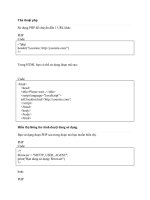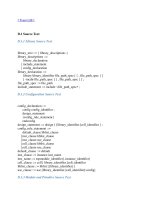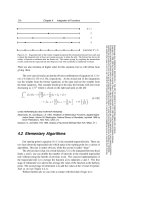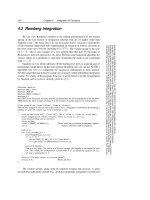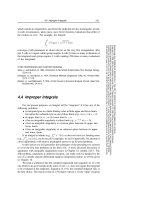Tài liệu Useful Modeling Techniques part 1 docx
Bạn đang xem bản rút gọn của tài liệu. Xem và tải ngay bản đầy đủ của tài liệu tại đây (21.26 KB, 7 trang )
[ Team LiB ]
9.1 Procedural Continuous Assignments
We studied procedural assignments in Section 7.2
, Procedural Assignments. Procedural
assignments assign a value to a register. The value stays in the register until another
procedural assignment puts another value in that register. Procedural continuous
assignments behave differently. They are procedural statements which allow values of
expressions to be driven continuously onto registers or nets for limited periods of time.
Procedural continuous assignments override existing assignments to a register or net.
They provide an useful extension to the regular procedural assignment statement.
9.1.1 assign and deassign
The keywords assign and deassign are used to express the first type of procedural
continuous assignment. The left-hand side of procedural continuous assignments can be
only be a register or a concatenation of registers. It cannot be a part or bit select of a net
or an array of registers. Procedural continuous assignments override the effect of regular
procedural assignments. Procedural continuous assignments are normally used for
controlled periods of time.
A simple example is the negative edge-triggered D-flipflop with asynchronous reset that
we modeled in Example 6-8
. In Example 9-1, we now model the same D_FF, using
assign and deassign statements.
Example 9-1 D-Flipflop with Procedural Continuous Assignments
// Negative edge-triggered D-flipflop with asynchronous reset
module edge_dff(q, qbar, d, clk, reset);
// Inputs and outputs
output q,qbar;
input d, clk, reset;
reg q, qbar; //declare q and qbar are registers
always @(negedge clk) //assign value of q & qbar at active edge of clock.
begin
q = d;
qbar = ~d;
end
always @(reset) //Override the regular assignments to q and qbar
//whenever reset goes high. Use of procedural continuous
//assignments.
if(reset)
begin //if reset is high, override regular assignments to q with
//the new values, using procedural continuous assignment.
assign q = 1'b0;
assign qbar = 1'b1;
end
else
begin //If reset goes low, remove the overriding values by
//deassigning the registers. After this the regular
//assignments q = d and qbar = ~d will be able to change
//the registers on the next negative edge of clock.
deassign q;
deassign qbar;
end
endmodule
In Example 9-1
, we overrode the assignment on q and qbar and assigned new values to
them when the reset signal went high. The register variables retain the continuously
assigned value after the deassign until they are changed by a future procedural
assignment. The assign and deassign constructs are now considered to be a bad coding
style and it is recommended that alternative styles be used in Verilog HDL code.
9.1.2 force and release
Keywords force and release are used to express the second form of the procedural
continuous assignments. They can be used to override assignments on both registers and
nets. force and release statements are typically used in the interactive debugging process,
where certain registers or nets are forced to a value and the effect on other registers and
nets is noted. It is recommended that force and release statements not be used inside
design blocks. They should appear only in stimulus or as debug statements.
force and release on registers
A force on a register overrides any procedural assignments or procedural continuous
assignments on the register until the register is released. The register variables will
continue to store the forced value after being released, but can then be changed by a
future procedural assignment. To override the values of q and qbar in Example 9-1
for a
limited period of time, we could do the following:
module stimulus;
//instantiate the d-flipflop
edge_dff dff(Q, Qbar, D, CLK, RESET);
initial
begin
//these statements force value of 1 on dff.q between time 50 and
//100, regardless of the actual output of the edge_dff.
#50 force dff.q = 1'b1; //force value of q to 1 at time 50.
#50 release dff.q; //release the value of q at time 100.
end
endmodule
force and release on nets
force on nets overrides any continuous assignments until the net is released. The net will
immediately return to its normal driven value when it is released. A net can be forced to
an expression or a value.
module top;
assign out = a & b & c; //continuous assignment on net out
initial
#50 force out = a | b & c;
#50 release out;
end
endmodule
In the example above, a new expression is forced on the net from time 50 to time 100.
From time 50 to time 100, when the force statement is active, the expression a | b & c will
be re-evaluated and assigned to out whenever values of signals a or b or c change. Thus,
the force statement behaves like a continuous assignment except that it is active for only
a limited period of time.
[ Team LiB ]
[ Team LiB ]
9.2 Overriding Parameters
Parameters can be defined in a module definition, as was discussed earlier in Section
3.2.8, Parameters. However, during compilation of Verilog modules, parameter values
can be altered separately for each module instance. This allows us to pass a distinct set of
parameter values to each module during compilation regardless of predefined parameter
values.
There are two ways to override parameter values: through the defparam statement or
through module instance parameter value assignment.
9.2.1 defparam Statement
Parameter values can be changed in any module instance in the design with the keyword
defparam. The hierarchical name of the module instance can be used to override
parameter values. Consider Example 9-2
, which uses defparam to override the parameter
values in module instances.
Example 9-2 Defparam Statement
//Define a module hello_world
module hello_world;
parameter id_num = 0; //define a module identification number = 0
initial //display the module identification number
$display("Displaying hello_world id number = %d", id_num);
endmodule
//define top-level module
module top;
//change parameter values in the instantiated modules
//Use defparam statement
defparam w1.id_num = 1, w2.id_num = 2;
//instantiate two hello_world modules
hello_world w1();
hello_world w2();
endmodule
In Example 9-2
, the module hello_world was defined with a default id_num = 0.
However, when the module instances w1 and w2 of the type hello_world are created,
their id_num values are modified with the defparam statement. If we simulate the above
design, we would get the following output:
Displaying hello_world id number = 1
Displaying hello_world id number = 2
Multiple defparam statements can appear in a module. Any parameter can be overridden
with the defparam statement. The defparam construct is now considered to be a bad
coding style and it is recommended that alternative styles be used in Verilog HDL code.
N
ote that the module hello_world can also be defined using an ANSI C style parameter
declaration. Figure 9-3 shows the ANSI C style parameter declaration for the module
hello_world.
Example 9-3 ANSI C Style Parameter Declaration
//Define a module hello_world
module hello_world #(parameter id_num = 0) ;//ANSI C Style Parameter
initial //display the module identification number
$display("Displaying hello_world id number = %d", id_num);
endmodule
9.2.2 Module_Instance Parameter Values
Parameter values can be overridden when a module is instantiated. To illustrate this, we
will use Example 9-2
and modify it a bit. The new parameter values are passed during
module instantiation. The top-level module can pass parameters to the instances w1 and
w2, as shown below. Notice that defparam is not needed. The simulation output will be
identical to the output obtained with the defparam statement.
//define top-level module
module top;
//instantiate two hello_world modules; pass new parameter values
//Parameter value assignment by ordered list
hello_world #(1) w1; //pass value 1 to module w1
//Parameter value assignment by name
hello_world #(.id_num(2)) w2; //pass value 2 to id_num parameter
//for module w2
endmodule
If multiple parameters are defined in the module, during module instantiation, they can be
overridden by specifying the new values in the same order as the parameter declarations
in the module. If an overriding value is not specified, the default parameter declaration
values are taken. Alternately, one can override specific values by naming the parameters
and the corresponding values. This is called parameter value assignment by name.
Consider Example 9-4
.
Example 9-4 Module Instance Parameter Values
//define module with delays
module bus_master;
parameter delay1 = 2;
parameter delay2 = 3;
parameter delay3 = 7;
<module internals>
endmodule
//top-level module; instantiates two bus_master modules
module top;
//Instantiate the modules with new delay values
//Parameter value assignment by ordered list
bus_master #(4, 5, 6) b1(); //b1: delay1 = 4, delay2 = 5, delay3 = 6
bus_master #(9, 4) b2(); //b2: delay1 = 9, delay2 = 4, delay3 = 7(default)
//Parameter value assignment by name
bus_master #(.delay2(4), delay3(7)) b3(); //b2: delay2 = 4, delay3 = 7
//delay1=2 (default)
// It is recommended to use the parameter value assignment by name
// This minimizes the chance of error and parameters can be added
// or deleted without worrying about the order.
endmodule
Module-instance parameter value assignment is a very useful method used to override
parameter values and to customize module instances.
[ Team LiB ]



